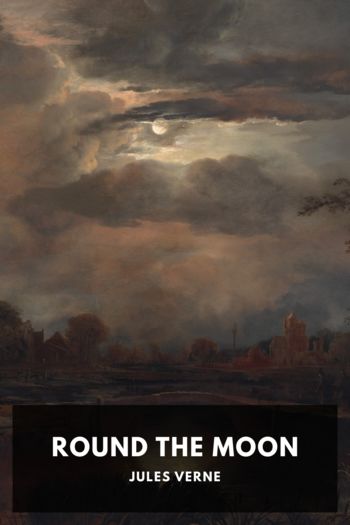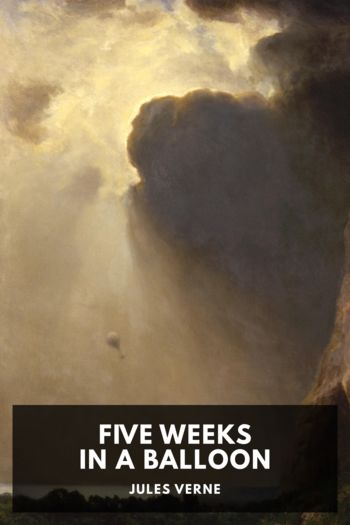From the Earth to the Moon, Jules Verne [beach books .TXT] 📗

- Author: Jules Verne
Book online «From the Earth to the Moon, Jules Verne [beach books .TXT] 📗». Author Jules Verne
In fact, it was by means of electricity that fire was to be set to this mass of guncotton. All these single wires, surrounded by isolating material, were rolled into a single one at a narrow hole pierced at the height the projectile was to be placed; there they crossed the thick metal wall and came up to the surface by one of the vent-holes in the masonry made on purpose. Once arrived at the summit of Stony Hill, the wire supported on poles for a distance of two miles met a powerful pile of Bunsen passing through a nonconducting apparatus. It would, therefore, be enough to press with the finger the knob of the apparatus for the electric current to be at once established, and to set fire to the 400,000 lbs. of guncotton. It is hardly necessary to say that this was only to be done at the last moment.
On the 28th of November the 800 cartridges were placed at the bottom of the Columbiad. That part of the operation had succeeded. But what worry, anxiety, and struggles President Barbicane had to undergo! In vain had he forbidden entrance to Stony Hill; every day curious sightseers climbed over the palisading, and some, pushing imprudence to folly, came and smoked amongst the bales of guncotton. Barbicane put himself into daily rages. J. T. Maston seconded him to the best of his ability, chasing the intruders away and picking up the still-lighted cigar-ends which the Yankees threw about—a rude task, for more than 300,000 people pressed round the palisades. Michel Ardan had offered himself to escort the cases to the mouth of the gun, but having caught him with a cigar in his mouth whilst he drove out the intruders to whom he was giving this unfortunate example, the president of the Gun Club saw that he could not depend upon this intrepid smoker, and was obliged to have him specially watched.
At last, there being a Providence even for artillerymen, nothing blew up, and the loading was happily terminated. The third bet of Captain Nicholl was therefore much imperilled. There still remained the work of introducing the projectile into the Columbiad and placing it on the thick bed of guncotton.
But before beginning this operation the objects necessary for the journey were placed with order in the wagon-compartment. There were a good many of them, and if they had allowed Michel Ardan to do as he pleased he would soon have filled up all the space reserved for the travellers. No one can imagine all that the amiable Frenchman wished to carry to the moon—a heap of useless trifles. But Barbicane interfered, and refused all but the strictly necessary.
Several thermometers, barometers, and telescopes were placed in the instrument case.
The travellers were desirous of examining the moon during their transit, and in order to facilitate the survey of this new world they took an excellent map by Boeer and Moedler, the Mappa Selenographica, published in four plates, which is justly looked upon as a masterpiece of patience and observation. It represented with scrupulous exactitude the slightest details of that portion of the moon turned towards the earth. Mountains, valleys, craters, peaks, watersheds, were depicted on it in their exact dimensions, faithful positions, and names, from Mounts Doerfel and Leibnitz, whose highest summits rise on the eastern side of the disc, to the Mare Frigoris, which extends into the North Polar regions.
It was, therefore, a precious document for the travellers, for they could study the country before setting foot upon it.
They took also three rifles and three fowling-pieces with powder and shot in great quantity.
“We do not know with whom we may have to deal,” said Michel Ardan. “Both men and beasts may be displeased at our visit; we must, therefore, take our precautions.”
The instruments of personal defence were accompanied by pickaxes, spades, saws, and other indispensable tools, without mentioning garments suitable to every temperature, from the cold of the polar regions to the heat of the torrid zone.
Michel Ardan would have liked to take a certain number of animals of different sorts, not male and female of every species, as he did not see the necessity of acclimatising serpents, tigers, alligators, or any other noxious beasts in the moon.
“No,” said he to Barbicane, “but some useful animals, ox or cow, ass or horse, would look well in the landscape and be of great use.”
“I agree with you, my dear Ardan,” answered the president of the Gun Club; “but our projectile is not Noah’s Ark. It differs both in dimensions and object, so let us remain in the bounds of possibility.”
At last after long discussions it was agreed that the travellers should be content to take with them an excellent sporting dog belonging to Nicholl and a vigorous Newfoundland of prodigious strength. Several cases of the most useful seeds were included amongst the indispensable objects. If they had allowed him, Michel Ardan would have taken several sacks of earth to sow them in. Anyway he took a dozen little trees, which were carefully enveloped in straw and placed in a corner of the projectile.
Then remained the important question of provisions, for they were obliged to provide against finding the moon absolutely barren. Barbicane managed so well that he took enough for a year. But it must be added, to prevent astonishment, that these provisions consisted of meat and vegetable compressed to their smallest volume by hydraulic pressure, and included a great quantity of nutritive elements; there was not much variety, but it would not do to be too particular in such an expedition. There was also about fifty gallons of brandy and water for two months only, for, according to the latest observations of





Comments (0)